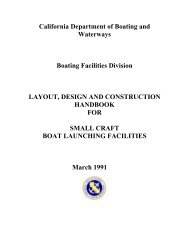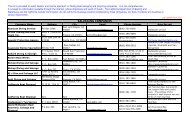EVEREST June, 2013 - California Department of Boating and ...
EVEREST June, 2013 - California Department of Boating and ...
EVEREST June, 2013 - California Department of Boating and ...
You also want an ePaper? Increase the reach of your titles
YUMPU automatically turns print PDFs into web optimized ePapers that Google loves.
Orange County Coastal Regional Sediment Management Plan<br />
• Federal <strong>and</strong> state endangered <strong>California</strong> least tern (Sterna antillarum browni);<br />
• Federal threatened western snowy plover (Chardrius alex<strong>and</strong>rinus nivosus) <strong>and</strong> critical<br />
habitat;<br />
• Federal endangered Southern <strong>California</strong> Steelhead (Oncorhynchus mykiss) evolutionary<br />
significant unit <strong>and</strong> critical habitat (“evolutionary significant unit” is a term developed by<br />
NOAA Fisheries (NMFS, 2012a) to describe distinct population segments <strong>of</strong> salmon<br />
under the endangered species act);<br />
• Federal endangered green sea turtle (Chelonia mydas);<br />
• Fully protected marine mammals such as <strong>California</strong> gray whale (Eschrichtius robustus)<br />
<strong>and</strong> protected dolphins, porpoises, seals <strong>and</strong> sea lions (Fully Protected is a designation<br />
used by the CDFG);<br />
• Fully protected <strong>California</strong> brown pelican (Pelecanus occidentalis californicus);<br />
• <strong>California</strong> grunion (Leuresthes tenuis) spawning beaches;<br />
• Pismo clam (Tivela stultorum), if within persistent clam bed areas; <strong>and</strong><br />
• Olympia oyster (Ostrea lurida), if within persistent oyster bed areas.<br />
Table 3.7 summarizes the regional distribution <strong>of</strong> coastal habitats in Orange County. The<br />
locations <strong>of</strong> many <strong>of</strong> these habitats in the vicinity <strong>of</strong> potential RSM areas are shown on Figures<br />
3.5 through 3.9.<br />
Figures 3.5 through 3.9 show locations <strong>of</strong> hard-bottom, canopy kelp, seagrasses, bays <strong>and</strong><br />
estuaries (including harbors), man-made hard-bottom structures, selected managed species,<br />
<strong>and</strong> RSM locations. The figures are intended to show the types <strong>of</strong> habitats <strong>and</strong> resources<br />
generally considered with coastal RSM projects involving beach nourishment, <strong>and</strong> include<br />
locations <strong>of</strong> receiver sites <strong>and</strong> sediment sources identified in Sections 3.1 <strong>and</strong> 3.2 <strong>of</strong> this report.<br />
The identified USACE sites include dredge <strong>and</strong> receiver areas that have been historically used<br />
within the region. The figure legends list a portion <strong>of</strong> the types <strong>of</strong> data in the project geographic<br />
information system (GIS). Individual figures show the available mapped data for different<br />
reaches <strong>of</strong> the study area where RSM activities have or may occur.<br />
The tan colored polygon called hard substrate includes bedrock <strong>and</strong> cobble; s<strong>and</strong> is the<br />
dominant habitat type <strong>of</strong>fshore <strong>and</strong> generally may be assumed in areas where hard-bottom is<br />
not shown. Some nearshore bedrock areas <strong>and</strong> embayment s<strong>of</strong>t-bottom areas include<br />
vegetated habitats.<br />
Everest International Consultants, Inc. 3.24




